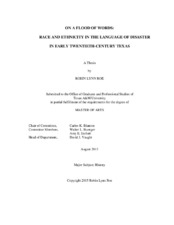| dc.description.abstract | My thesis will show that newspaper reports on weather-related natural disasters in Texas and the Southwest borderlands between 1899 and 1921 reflect the change in racial and ethnic identities during the rise of the Jim Crow system, but also how reporting helped shape those changes. I will examine the language used in this reporting and compare differences in treatment and presentation based on race and ethnicity and how this changed throughout the period, including the absence of information about certain victims and how class, gender, and age played a role in reporting. I will analyze graphic art and photography used in newspaper reports on the disasters for ways in which perceptions of race, ethnicity, and class influenced their selection. I will include diversity in the disaster types, geographical areas, and the victims’ race, ethnicity, gender, and class. As weather-related natural disasters, particularly hurricanes, often extend over large geographic areas, I track the reporting of such storms outside my primary area where appropriate. In contrast, I will examine highly localized events such as diffused smaller flooding events that primarily impacted specific ethnic populations or geographic areas.
My sources include both Texas newspapers and major newspapers outside the region, including a broad sample of reporting—between six and twelve different newspapers for each disaster. Because many of the newspapers began or ended publication between 1899 and 1921, the choice of newspapers varies from disaster to disaster, but the Dallas Morning News, the New York Times, and the Atlanta Constitution will provide continuity for most of the disasters. I will analyze over 2600 newspaper articles on these weather-related natural disasters for their depictions of the victims, rescuers, responders, and other related persons. First, I analyze how race, ethnicity, class, and gender are used to manipulate or redefine these identities and to reinforce systems of control. Second, I examine how elite male control of labor and labor migration is reinforced through racialization and stereotyping of poorer victims in reporting in which class is as vital as racial or ethnic classification. Finally, I visually analyze a number of related images from the newspaper reporting, both drawings and photographs, for the ways in which they reinforce racial and class hierarchies. Throughout the thesis, I will closely follow the evolution from a multi-racial and multi-ethnic system to the uniquely Texan tri-racial system during this twenty-two year period. | en |


